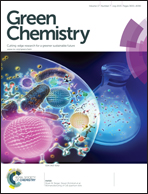N-Substituted carbamate synthesis using urea as carbonyl source over TiO2–Cr2O3/SiO2 catalyst†
Abstract
The use of urea as an active form of carbon dioxide is a feasible way to substitute phosgene in the chemical industry. This paper reports an effective route for the synthesis of N-substituted carbamates from amines, urea and alcohols. Under the optimized reaction conditions, several important N-substituted carbamates were successfully synthesized in 95–98% yields over a TiO2–Cr2O3/SiO2 catalyst. The catalyst could be reused for several runs without deactivation. The catalysts were characterized by BET, XPS, XRD, and TPD, which suggested that the strength and amount of the acidic and basic sites might be the major reason for the high catalytic activity of TiO2–Cr2O3/SiO2.


 Please wait while we load your content...
Please wait while we load your content...